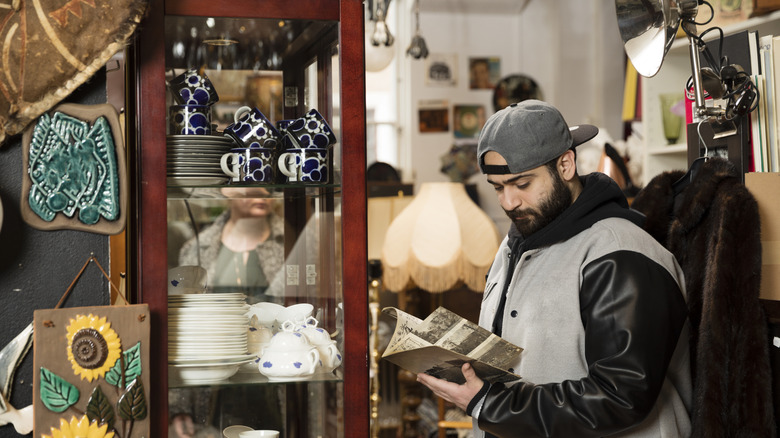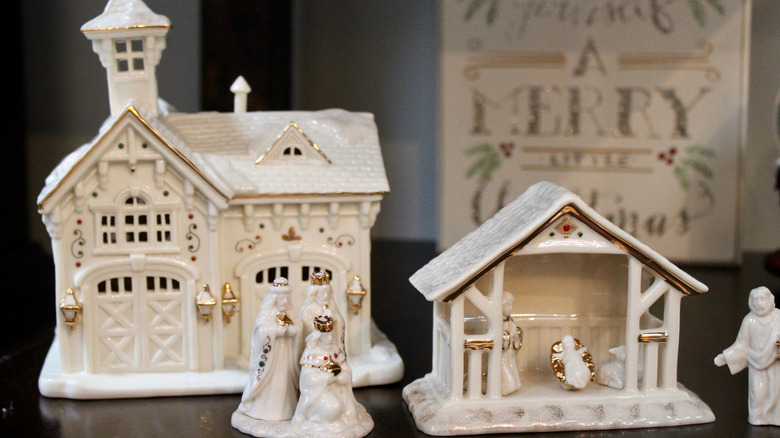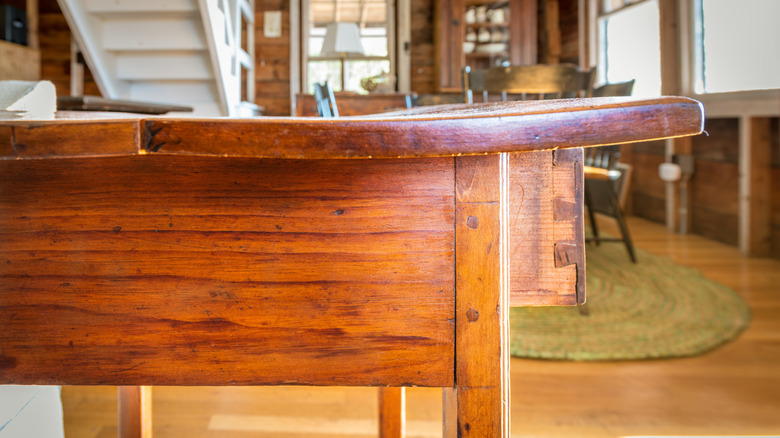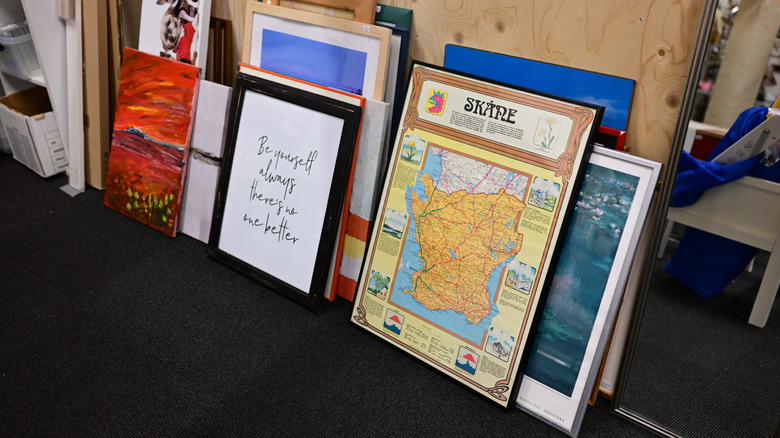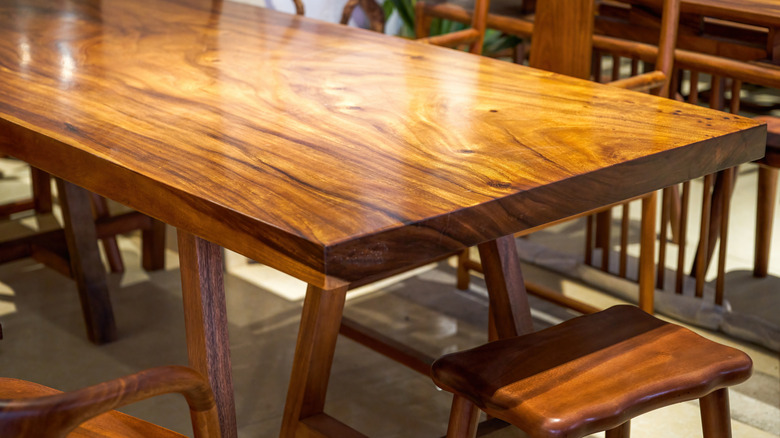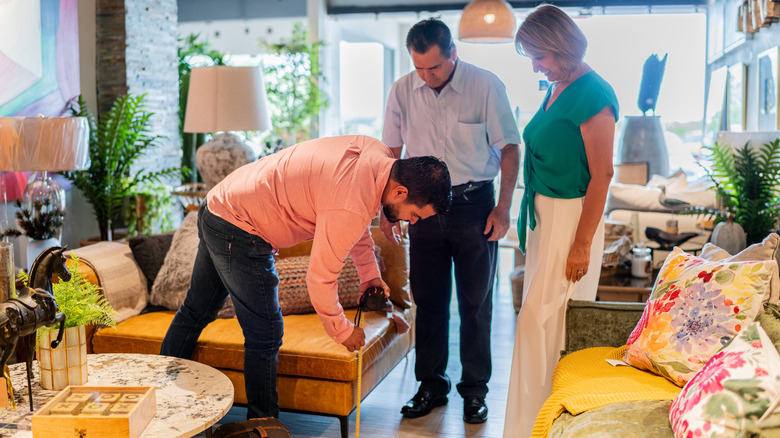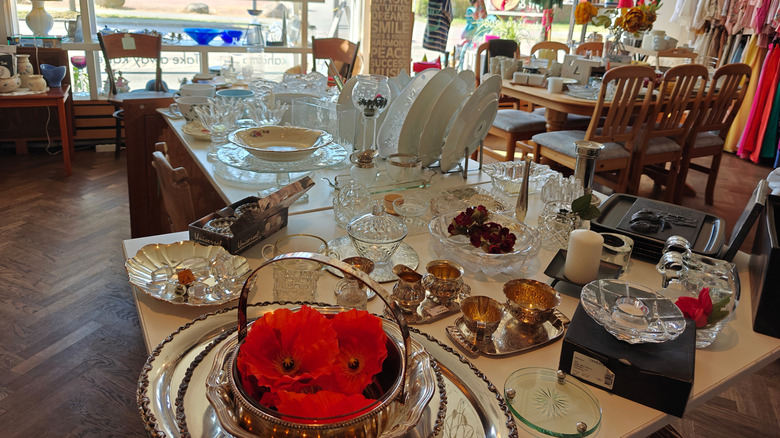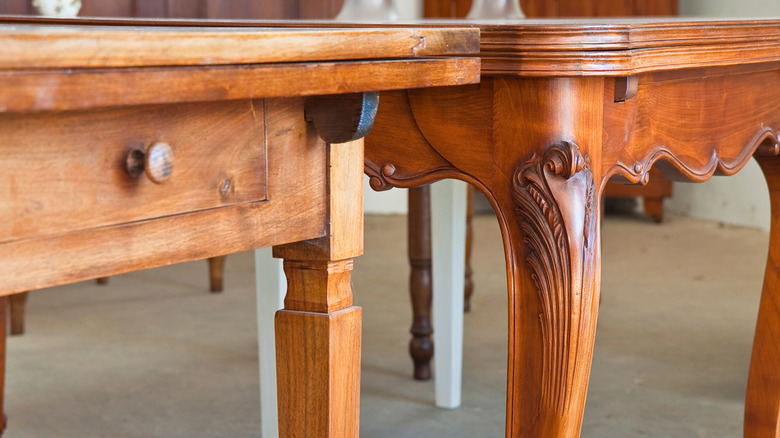Tips On How To Spot Valuable, High-End Items At Thrift Stores
A trip to the thrift store is like a scavenger hunt for adults. You never know what you'll discover among the shelves of knickknacks, books, and kitchenware. If you're lucky, you'll score a high-end item at a bargain price. But for that to happen, you need to know how to tell the junk from the treasures. That's not always easy to do — just look at all of the knock-off Louie Vuitton purses that are sold on the daily. It's also possible to be duped by home decor and furniture pieces that you find at the thrift store. Is that really a classic mid-century modern dining table, or is it a modern-day replica made to fit the popular design style? That's why it's important to learn about common high-end items you could find in secondhand shops, and how to identify quality while you're thrifting.
Name brands and maker's marks are two common ways to spot high-end brands that could be valuable — especially if you study up on which of those brands to look for. But there's more to finding high-value items, whether you're on the hunt for a luxury item for your home or you want to resell the items to make a little money. Paying attention to construction methods, materials, the weight, and the little details of the piece could help you recognize a winner when you see it. Sure, you can buy cheaper items for simple DIY thrift flips to make them into something special, but finding a high-end piece that's ready to go on display feels like you've won the thrifting lottery. Luckily, there are some solid indicators to look for and a few tools that can help.
Look for maker's marks
Finding a maker's mark is one way you can authenticate your latest thrifting find. A maker's mark' is a distinct mark often found on older furniture, jewelry, pottery, and other pieces to show who made it. The mark could represent the designer, craftsperson, or manufacturer. Every maker's mark is different and could be an engraving, stamp, label, branding, metal tag, or other formats. Some include symbols or images, company logos, individuals' names, company names, locations, dates, or other identifying information. Finding a maker's mark can help you verify that the piece is authentic, and it could give you information about when and where it was produced. However, a lack of a mark doesn't mean the item is worthless. Not all makers used marks, and the marks could wear away over time anyway.
To locate a maker's mark, look in hidden spots. On furniture, check on the inside or on the bottom of drawers, back panel, legs, frame, or near joints. On pottery or ceramic pieces, the maker's mark is often on the back or bottom. Then, research to find out what the maker's mark stands for, how valuable the item is, and if the maker's mark is authentic (yes, you could come across fakes). That's where Google Lens comes in handy. To use it, take a picture of the maker's mark or the item as a whole. You can then search for it. This process could help you identify the company, type of item, and approximate age, if those details aren't obvious from the labeling. Compare what you see to authentic marks from the same company to look for subtle differences that could indicate it's a fake. Then, research the brand and the specific item to estimate its value.
Learn and look out for particular brands
What's one of the easiest ways to spot high-value items at the thrift store? Knowing what brands to look for! Many brands are just known for their quality, or they have such a strong reputation that the vintage items from those companies have a high value. You'll find a mix of companies that still exist, as well as vintage makers that were the stars of their day, but no longer operate. Having a list of go-to brands and manufacturers to thrift (as well as having an idea of what their signature products look like) can help you target your search. You could easily pass over a high-value treasure if you're not familiar with common brand names.
It's impossible to know every high-value brand you might come across during your thrifting adventures. So, instead of trying to memorize them all, narrow down the types of items you want to look for. Maybe you're on the hunt for a perfectly preserved piece of furniture with a rich history. In that case, research brands like Herman Miller, Drexel Heritage, Thomasville, and Henredon. Even larger categories of items, like glassware, can be broken down into subcategories with distinct brands. Take vintage glassware — brands like Murano and Steuben are at the top for art glass. Elegant glass companies that are often sought after include Heisey and Cambridge. If you collect carnival glass, you'll want to learn about brands like Millersburg and Imperial.
Inspect the construction detaills
Even if you're not familiar with popular vintage brands and can't find a maker's mark on a piece, it could still be a high-quality piece that's worth a lot of money. It often comes down to the details. There are several signs antique furniture may not be authentic, and the construction details are one of the indicators. Low-quality construction is often a sign of an inferior brand that's not as valuable as what it's trying to replicate. You could also come across a new piece of furniture that's made to look like an antique piece. The details like the joints and frames could help you spot those lower-value imposters. While this tip largely applies to furniture pieces, it's also an important factor for other items. Fabric finds, like curtains or tablecloths, are often higher value when the stitching is secure and the hems are even, for example.
Inspect the areas where the piece comes together. Look for a sturdy piece that still functions as expected. When it comes to the connections of wood, dovetail joints are often considered superior to other methods. Dovetail joints connect two pieces of wood at a 90-degree angle, with one piece featuring angled tail-like cuts and the other having opposite cuts so the two pieces fit together firmly. Another sturdy method is the mortise and tenon joint, which features a protruding tenon on one piece that fits firmly into an opening, called a mortise, on the adjoining piece of wood. Sturdy frames that are connected with nails or screws, rather than staples, and that have corner blocks are often higher-end as well.
Look for art with pencil signatures or numbered prints
If you're looking to spruce up your space, you may want to thrift your wall art instead of buying from home decor stores. You'll often have to dig through a lot of mass-produced, tacky decor to find hidden treasures in the art department. Of course, the mass-produced prints can be the perfect find for your home if they fit your vibe and speak to you, but you may get lucky and score a piece of secondhand art at a thrift store, flea market, or estate sale that's worth a lot. Originals are typically more valuable than prints, so learning the difference is helpful. However, many prints are also very valuable, depending on how many were made and what methods were used to produce them.
To score a high-value piece of artwork, familiarize yourself with the indicators on the pieces that designate them as unique. Then, inspect any artwork you're considering to look for those details. You may have an original piece if you see visible brushstrokes, gallery stickers, artist notes, pencil sketch marks, or signatures. It's probably not an original if you see noticeable print patterns or a uniform texture. That being said, original prints can also be valuable, especially if the artist signs them. Finding a print from a limited edition could also mean you have something valuable. That's especially true if the run was small — finding a print that was limited to no more than 50 prints could be highly valuable. Look for an indicator of what number print you have. Seeing "55/100" means yours was the 55th print to be made out of 100 in that edition.
Check the weight and density of items
It might not be polite to bring up weight when it comes to people, but it's an important factor in helping you determine the quality of a thrifted piece. The heavier a piece is, the more likely it is to be made out of higher-quality materials, which typically makes it more valuable. For example, a solid wood dresser will weigh more than a particle board dresser that's the same size. High-end brands are more likely to use real wood than particle board. The same goes for many other high-quality durable materials — real stone is heavier than composites made to look like stone, crystal is heavier than glass, solid brass tends to weigh more than brass-plated items, and cast iron is often heavier than aluminum or steel. Sometimes, a lighter weight is beneficial — lighter patio furniture is easier to move than heavy cast iron, for example. But heavier items are typically higher quality.
When you spot an item you like in the thrift store, pick it up to see how it feels. If it feels lighter than you'd expect based on the size and assumed material, you could be holding an item made from an inferior material. For decor pieces, the weight could help you assess if the piece is a solid material that's crafted with care or is a mass-produced piece that's hollow inside, which could make it worth less and more likely to break.
Learn what high-end wood looks like and what kind luxury labels gravitate towards
When you're looking for furniture pieces, the first step is to learn how to identify fake vs. real solid wood. Real wood typically has a distinct and variable grain and is heavier and sturdier than copycat materials. But even real wood comes in a range of species that affect the quality and value of the piece. Teak, walnut, mahogany, and rosewood are examples of high-end wood species that often indicate value in a piece. Learning how to identify those types of wood can also help you spot the most valuable wood pieces in a thrift store.
Inspect the details of the wood closely to determine what species an item is. Teak is often used for outdoor furniture and takes on a golden or medium brown color with a straight grain. Walnut is typically darker with a chocolate brown coloration with a fine texture, tiny pores, and a tight, straight grain that may have some curving to it. If a piece is made of mahogany, it often has a reddish-brown hue that darkens with time, and true mahogany should have visible pores and a straight gain, usually without many knots or gaps. With rosewood, you'll notice a wide range of grain patterns, often with waves or curly ribbons, and knots and dark streaks are also common. You may have some luck using Google Lens to help identify the wood species if you're unsure. If you can determine the manufacturer, you can also research what species of wood that company typically uses.
For upholstery, look for luxury materials
When thrifting upholstered pieces or other items that use fabric, the fabrics and construction methods used can help you pick out high-value items. Natural fibers almost always make a piece worth more than synthetic fabrics. Focus on upholstered pieces made with leather, silk, cotton, wool, and linen. If fabrics have patterns, the way those patterns align at the seams (high-quality items should align perfectly) can indicate how much care and craftsmanship went into the production of the piece. You can also determine the quality, and how likely it is to be higher value, by looking at the stitching, edges, and smoothness of the fabric.
Check for labels under the cushions or on the bottom of the piece to determine the materials used, or inspect the fabric closely to determine what it is. For example, genuine leather has natural hide markings, a slightly bumpy texture (like skin), and that distinct, earthy leather smell. But if it's super rough or bumpy, that could indicate poor construction, split leather (which is not high quality), or damage that makes the item less valuable. Inspect the seams to make sure they're straight and that patterns align perfectly. Ideally, the stitching on any fabric, from upholstered furniture to curtains, will be tight and secure with even spacing between each stitch to show the quality craftsmanship.
Tap and listen to the sound to determine if an item is glass or crystal
Cut glass and crystal can look similar, whether you're thrifting drinkware or decor. Crystal is technically a type of glass with a higher lead oxide content. It's also typically more expensive and valuable than cut glass objects, which is why you'll want to learn how to identify crystal. While both can make a beautiful addition to your decor, when you're focusing specifically on thrifting high-value items, you'll want to hold out for crystal glassware.
One easy way to distinguish the two is to tap it with your fingernail. If you're holding crystal, you'll hear almost a musical-like sound similar to a bell ringing. You want the sound to last for a while — that means it has a higher lead content. You won't get that ringing sound with cut glass. Taking along a flashlight can also be helpful with determining glass vs. crystal. You should notice more clarity and less cloudiness when you shine light through crystal. Crystal glassware also tends to show blue or purple hues and has a prismatic effect with light. You'll also notice that crystal feels heavier than glass, and typically has rounded edges.
Check for intricate details that speak to the craftsmanship
If you want to successfully buy antique furniture for your home, looking for hand-crafted detailing could help, as they can be particularly telling when it comes to the age and value of a wooden piece. In many cases, you don't want perfection when you're looking for high-end wood furniture. When a piece is made by hand, there will likely be subtle variations or imperfections, because the work is done by a person and not a machine. For example, a hand-finished piece might show slight differences in the sheen and color throughout, which can add to the character. Inlays can also indicate a higher value, due to the craftmanship required to accomplish the design.
As you inspect wood furniture pieces, take a close look at the decorative detailing to see if it looks hand-crafted. When wood is hand carved, it typically has some variations in the designs, creating a more organic look. You might see tool marks or variations in the depth of carvings. Look closely at wood inlays to see how well they fit into the piece. You may also be able to spot a hand-crafted wood pieces by checking less visible areas. An artisan-made piece often includes carving and other detailing even in those less visible areas whereas a mass-produced piece might remain largely unfinished on the insides, backs, or undersides of the furniture.
